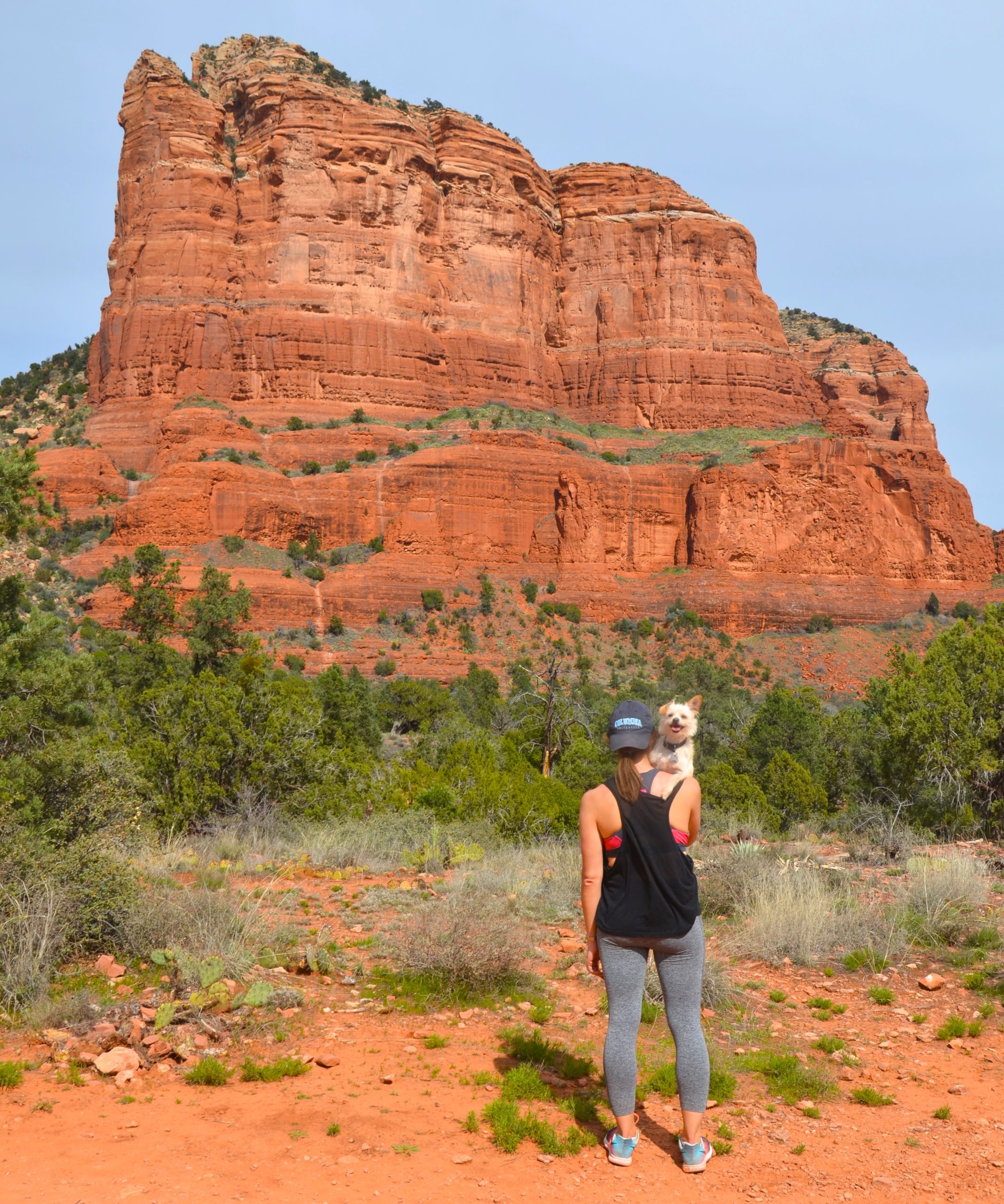By Melissa Kandel
Travel, as the act of going from one place to another, is said not to be about reaching a particular destination but instead, about discovering a whole new state of mind.
Or so I read on a bottle of that weird fizzy tea.
I began my road trip to Sedona, AZ with such a foolishly sanguine mindset, planning not one thing to do while wander-lusting in the Arizona wilderness but breathe canyon air, traverse forgotten dirt roads and gaze at soaring rock formations that spoke, in red-layered etches of beauty, about how awesome nature could be.
I’d seen the pictures of the landscape—feral, gargantuan crimson formations juxtaposed with flat—and was ready for my no-Wi-Fi, no-cell service date with the desert. I spent the past week in Phoenix for a work trip and planned to drive to Sedona on a Wednesday morning, check into my adorable little, high-beamed wood lodge by a creek—with hot tub and fireplace!—by noon then explore the land until sunset when I’d escape somewhere on a hilltop with a bottle of wine. It would be there that I’d take in the glorious dusky sun dipping below a skyline of intermittent canyons, turning everything golden, gooey and incandescently bright.
But before I tell you what really happened in Sedona (because what happens in Sedona goes on this blog), a history lesson: The town owes its name to the Schnebly family, whose surname elicits creative character jealousy on my part because it makes me think of these sniveling, bone-thin yet tall people who are abundantly stuck up and only like a certain kind of hairdo and wear khaki undershirts and eat out of bowls made from silver lace. (They weren’t like that I don’t think.)
Anyway, a man by the name of Dorsey Ellsworth Schnebly, of poor health and seeking warmer, fresher clime, came upon the land in the early 1900s and settled there, convincing his brother, T.C. Schnebly and wife Sedona (aha!) to live among this desert oasis.
In late 1901, T.C. and Sedona traveled from their home in Missouri, bought an 80-acre plot from a man called Frank Owenby (OMG these names are fun) and built a large house with two stone fireplaces near what is today Los Abrigados Resort and Tlaquepaque Arts and Crafts Village. About 15 homesteaders joined T.C. and his wife on the vast property but, as those pesky settlers often do, the townsfolk started acomplain’ about the slow mail service and so T.C., dutiful guy he was, applied for the establishment of a post office on his land.
Apparently, post office masters in the early 20th century were all about minimalism because after submitting several two- and three-word monikers for the post office—Schnebly Station, Red Rock Crossing, Oak Creek Station—all were rejected by the Post Master of Washington, D.C. for being too long to fit on a cancellation stamp. It was good, ol’ Dorsey Ellsworth who suggested using T.C.’s wife’s name and said the post should simply be: Sedona.
“You’re going to have a town named after you,” said Dorsey Ellsworth to Sedona, and we can probably guess that every family dinner after that started off with Sedona saying, “But really, T.C., why did your brother have to be the one to come up with naming the town after me? Don’t you even care at all?”
Just kidding. I don’t know what those two crazy kids talked about over dinner. Plus, by all written accounts, Sedona, a young bride in her mid-20s, was a pleasant character, and beloved in the burgeoning town for her contributions to the community; she even planted a delightful Victorian garden, which became a showcase patch of horticultural brilliance in Sedona that still stands today.
So, I guess that foray into the historical nomenclature of the area brings us back to the present, and to me, on that hilltop, staring at a waning sun and dreaming of rose petals and lollipops.
Or not.
“Excuse me, where are you going?”
The woman who asked the question was the human embodiment of the crass tone she used to solicit it. Blotchy, rough skin that curdled around a wide, pebbly, red face, slits for eyes and a wobble of nostrils and dried flesh that somehow formed a buttonish thing in the place where her nose should be. She had the kind of teeth that were covered in gums—I think dentists say recessed—and so whenever she spoke, it was all goopy pink and slobbery gum-drool. She was probably about 300 pounds heavier than her body wanted her to be and her bright-pink smile belied the cruel character of divisiveness thrumming beneath her oral misgivings.
I don’t often loathe—or even judge—people on first sight but this woman, in the fairy tale narrative that was my Sedona trip, happened to be the demonic witch set on destroying the princess as she stood in her rock-tower high on a hill.
“I’m just going to the bathroom,” I told her, reminding the woman that minutes before I had walked into her very office, attempting to check into my room, which she said wouldn’t be ready for another three hours—at 3 o’clock.
Don’t you remember us talking?
“Oh. Fine. Go.”
Her son popped out, seemingly from beneath the front counter, which was actually just stacked shelves housing gemstone rings that looked more like sorry crackerjack jewelry than actual gems anyone should ever buy. He spilled the contents of a potato chip bag onto the dusty counter and ate the chips one by one, staring at me between crunchy bites. The son looked like a younger, smaller, male version of his mother—excessive gums and all—except instead of hair that fell in flat oil slicks down an oblong head, he had short, spiky blonde locks that grew in every direction but the right one. He crumpled his mouth my way. I nodded a feeble hello.
“Also, do you happen to know any place good for dinner?” I asked the woman, half wanting a response, half trying to divert my attention from the dust-collected chips her son was devouring.
“Hey there’s a DQ up the road, you should have dinner there!” The son squealed and I smiled because unlike his mother, he had a certain ebullient charm that couldn’t be denied.
Not to gloss over the rest of the trip but this was probably the most thrilling exchange to happen in my 24-hour Sedona stay.
After I left the hotel office, I drove down the one-lane, traffic-ridden road—stop-gapped in the middle by a town ripped straight out of a Disneyland ride with its faux-Wild West cheesiness—to Red Rock State Park.
After a romp around Bell Rock (yes, that hike was undeniably beautiful), the next stop was at a terrible winery that served a $25 cheese plate consisting of two pieces of slopped-together, old American cheese and a goop of dried-up jam. The winery was followed by a drive down a twisty, mountain road to Flagstaff for dinner, although the desolated town offered little in the way of edible food, or really, in the way of anything at all. Finally, it was back to my hotel “cabin,” which turned out to be a musty room built in approximately 1963. Oh and the hot tub? No. That thing was actually a very large bath placed right by the bed (this was as weird as you’d imagine a bath by a bed would be) and of course, the fireplace didn’t work. The space smelled of decades-old toenail clippings and ham sandwiches. The toilet didn’t flush.
Still, despite its hospitality, cheese and traffic deficiencies, Sedona is still completely and breathtakingly gorgeous and who am I to hate on such unspoiled natural terrain? So, let me just stop complaining/writing/Schneblying and let you experience Sedona for yourself, through a select few photos taken at the scene:
(Also, that dust-eating child was right and DQ would’ve probably been the best choice for dinner.)








I didn’t know you write travel pieces as well. And is that your dog?
I love travel writing! I think some of the best journalism lives inside the pages of those in-flight magazines. And yes, that’s my 11-lb. rescue terrier. He’s just as sassy, adventurous and energetic as he looks in the pictures. 😉
they say the traveler sees what she sees, and the tourist sees what she has come to see… you’re no tourist. this is a lovely and inspiring post.
Love that! Thank you!